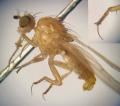Diptera.info :: Identification queries :: Diptera (eggs, larvae, pupae)
|
larvae in the rain barrel -Chironomidae?
|
|
| Sundew |
Posted on 03-08-2013 22:35
|
|
Member Location: Berlin and Baden-Württemberg, Germany Posts: 3938 Joined: 28.07.07 |
Hi, Here are other larvae and pupae from the rain barrel of thread http://www.dipter...d_id=56121. The little red "worms" were constantly wriggling through the water. I learned that the red colour is due to a haemoglobin analogue and that they capture oxygen by their undulating movements. Again, I firstly considered the pupae different animals because of their deviating colour and the white hair brushes on the head. Now I would like to ask: do the red larvae and the pupae belong together, and can a genus be identified? Many thanks, Sundew Sundew attached the following image:  [134.84Kb] |
|
|
|
| atylotus |
Posted on 04-08-2013 08:10
|
|
Member Location: Amsterdam, NL Posts: 1166 Joined: 29.05.09 |
yes they belong together, all genus Chironomus. The larvae has typical two pairs of ventral tubuli at the end, the pupa is a different matter, and you have to trust me on that.... |
|
|
|
| Sundew |
Posted on 04-08-2013 13:04
|
|
Member Location: Berlin and Baden-Württemberg, Germany Posts: 3938 Joined: 28.07.07 |
Of course I believe you - many thanks indeed! Can the other inhabitants of the rain barrel (http://www.dipter...d_id=56121) be identified, too? |
|
|
|
| John Carr |
Posted on 07-08-2013 04:13
|
|
Super Administrator Location: Colorado, USA Posts: 10537 Joined: 22.10.10 |
The "white hair brushes" are branched respiratory organs, derived from the simple "ears" typical of Culicomorpha. They have a few branches in many Chironominae and reach their peak of complexity in Chironomus. I assume they are branched because the species lives in water with little oxygen. Fine hairs have more total surface area. Branched respiratory organs have evolved independently in Simuliidae. |
| solito de solis |
Posted on 08-08-2013 19:20
|
|
Member Location: Liege, Belgium Posts: 404 Joined: 05.08.13 |
Hey, chironominus for sure this could be chironominus plumosus here the video http://www.youtub...AralgkLaOw and could not be chironominus uliginosus http://www.youtube.com/watch?v=gAralgkLaOw we should see the antennae and lauterborn organes to tell mor cordialement Edited by solito de solis on 08-08-2013 19:26 |
|
|
|
| atylotus |
Posted on 10-08-2013 16:38
|
|
Member Location: Amsterdam, NL Posts: 1166 Joined: 29.05.09 |
In the Netherlands alone there are over 20 species of Chironomus, whom as larve can only be identified using a dissecting microscope. You have to look at the presence or absence of lateral tubuli and gula-spot, the size and number of striae on the ventromental plates and some other features which all cannot be seen at these photo's. Pupa are even more difficult and even experts leave them to genus level. |
|
|
|
| Jump to Forum: |













